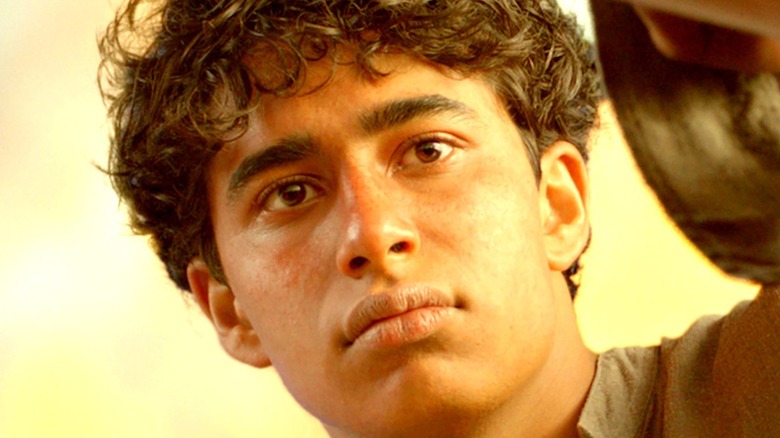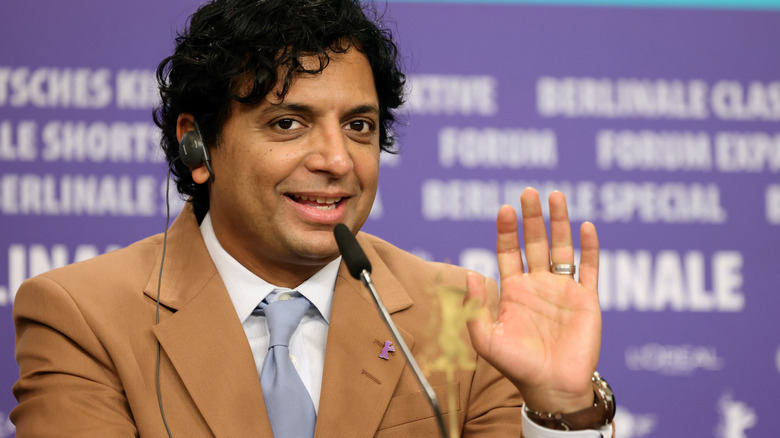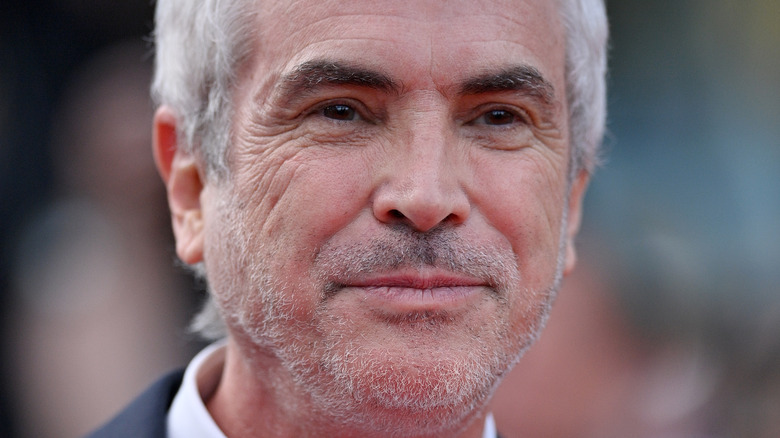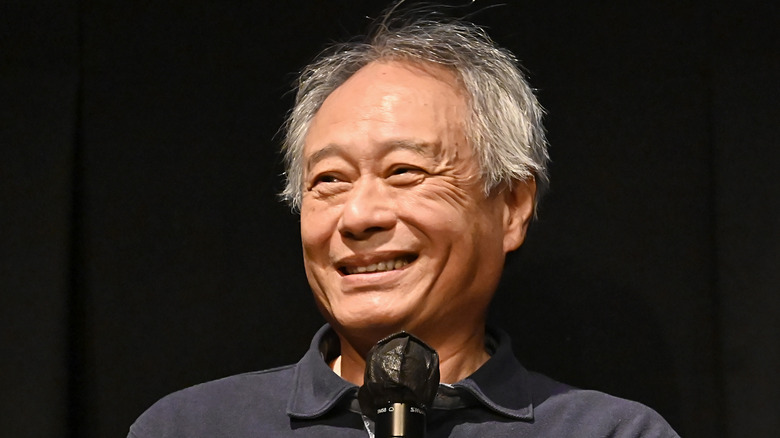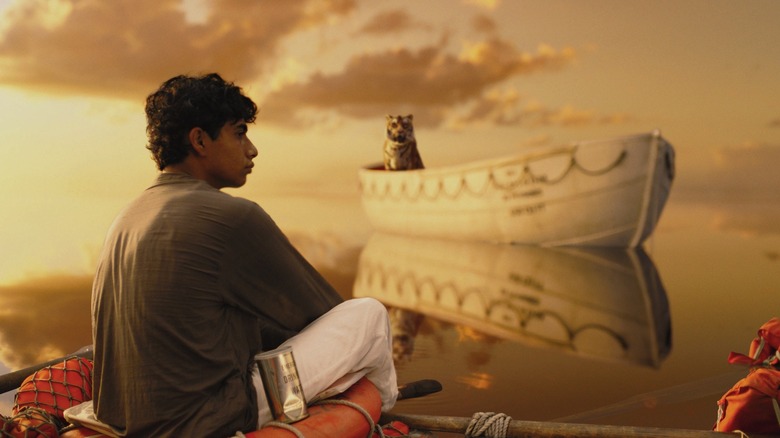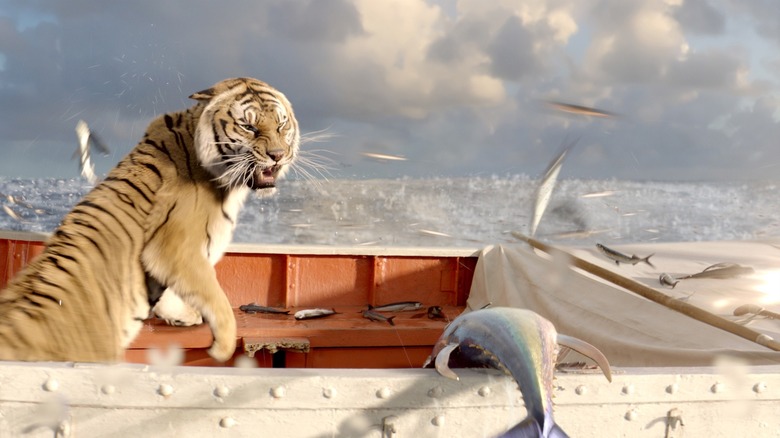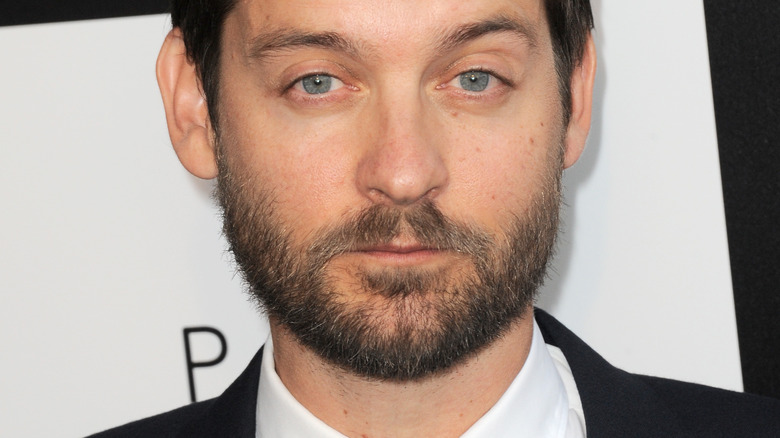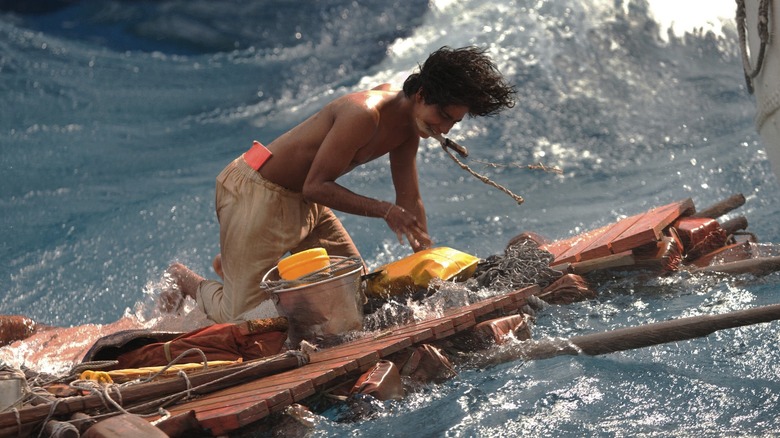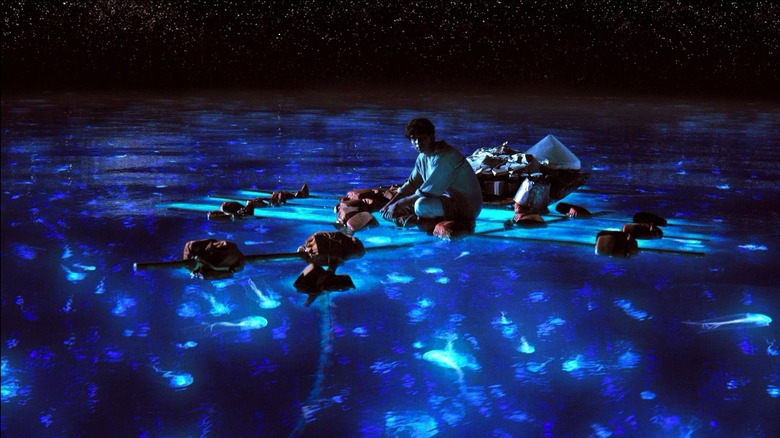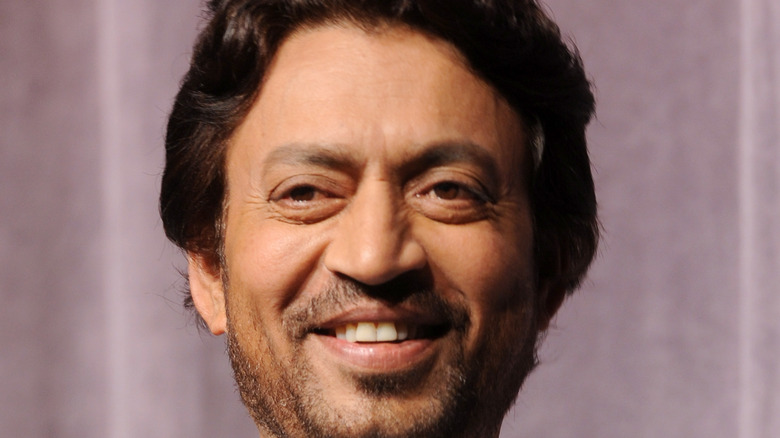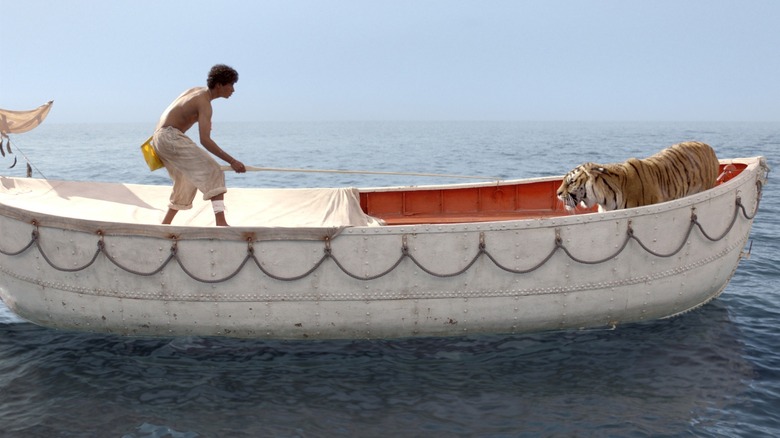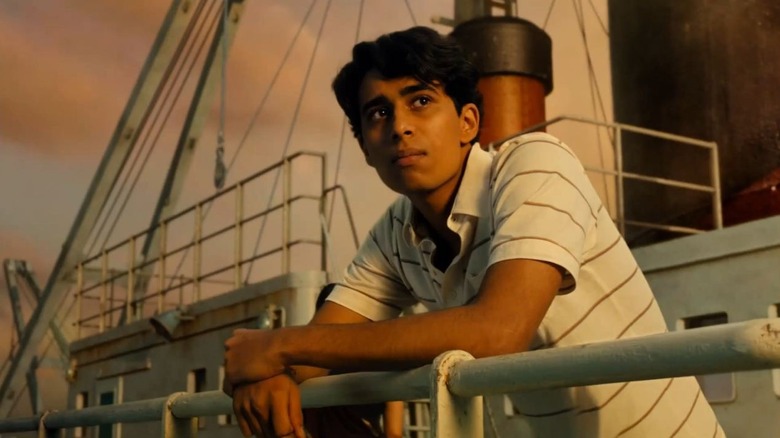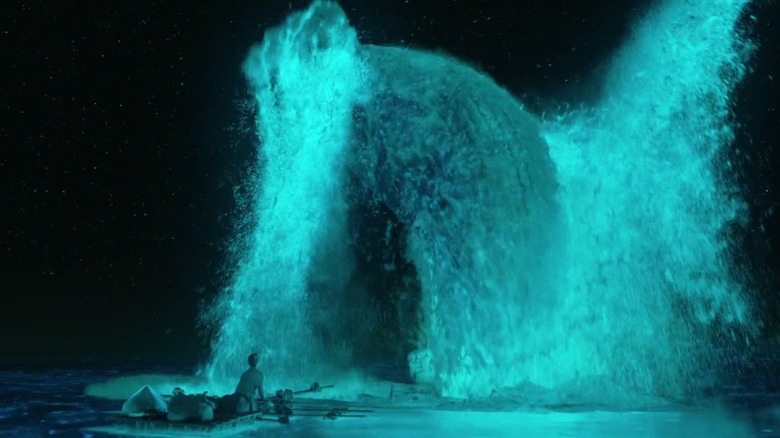Set Sail With These Life Of Pi Facts Only True Fans Know
"Life of Pi" began its existence as a novel of the same name by Yann Martel, but it could not be contained to the world of literature forever. Eventually, it made its way to the big screen as a feature film directed by Ang Lee, brought to life through groundbreaking visual effects techniques. As a motion picture, "Life of Pi" was a unique concoction, a contemplation on spirituality that also made heavy use of a CGI tiger and elements of classic survival dramas. The creative audacity on display in this feature was tremendous and helped to secure "Life of Pi" a sizeable presence once award season rolled around.
Though pop culture has been basking in the lasting influence of "Life of Pi" for years now, getting this project off the ground wasn't exactly an easy task. Gazing back into the history of this project, including critical events that occurred once it was in movie theaters across the world, demonstrates how much care went into this movie as well as how much passion (both good and bad) "Life of Pi" inspired in others. Many of these details about "Life of Pi" aren't common knowledge even for hardcore fans of the movie, but that doesn't make them any less integral to the history of this book adaptation.
M. Night Shyamalan was going to direct Life of Pi
The process of bringing "Life of Pi" to the silver screen went on for years. The unorthodox nature of its source material, not to mention all the visual effects wizardry necessary to bring it to life, always made this a complicated project to realize. "Life of Pi's" existence as a movie began with M. Night Shyamalan, who was the first filmmaker attached to direct this adaptation. This was a massive get for "Life of Pi," as Shyamalan was still basking in the glow of the success of movies like "The Sixth Sense" and "Signs." At this point in his career, Shyamalan could go anywhere — and he chose to sign on to "Life of Pi."
This was an especially interesting choice for Shyamalan because "Life of Pi" was based on pre-existing source material. Save for projects like "The Last Airbender," Shyamalan has largely confined himself to either original movies or sequels to his prior films, he doesn't seem to have much interest in adapting other people's concepts. "Life of Pi" was gearing up to be an exception for the auteur until Shyamalan dropped out of the directors chair. Shyamalan later explained to Entertainment Weekly that he opted to pass on the project because its source material contained a twist ending. Given how much audiences associate him with surprise conclusions, Shyamalan thought "Life of Pi" would be better off not being weighed down by his reputation.
Alfonso Cuaron almost directed Life of Pi
Alfonso Cuaron loves a good challenge. Just look at his 2013 film "Gravity," which used state-of-the-art visual effects techniques to create an unprecedented survival thrille, or "Harry Potter and the Prison of Azkaban," in which Cuaron opted to introduce new flourishes, such as the main kids wearing everyday clothing rather than just school uniforms, into the established visual norms of the franchise. At one point, it looked like Cuaron's love for daunting cinematic challenges would include figuring out how to translate "Life of Pi" into a movie.
Variety reported in March 2005 that, though M. Night Shyamalan was no longer directing "Life of Pi," the film was angling to get a new prolific filmmaker in the form of Alfonso Cuaron. This announcement came with the caveat that some issues were being ironed out over getting Cuaron for the film. The biggest of these was getting Warner Bros. to co-finance "Life of Pi" with 20th Century Fox so that the latter studio could have access to Cuaron. Still, this seemed to be a promising union that could ensure "Life of Pi" would be brought to life by a gifted auteur with visual effects experience. However, Cuaron would end up helming other projects like "Children of Men" instead, leaving "Life of Pi" without a director once again.
What drew Ang Lee to Life of Pi
After years of trying to nail down a director who would take on this project, "Life of Pi" finally found a proper filmmaker with Ang Lee. In retrospect, this audacious artist was a perfect fit for the project since "Hulk" established that Lee is a fan of using cutting-edge visual effects techniques for more contemplative purposes.
But there were deeper reasons why Lee decided to embark on such an ambitious project. The filmmaker explained to First Showing that he had long been a fan of the original "Life of Pi" book by Yann Martel, but it never struck him as something that would easily translate into a movie. Once Fox approached him to direct the film adaptation, this challenge began to tantalize Lee, especially once he figured out both a story structure for this adaptation and the ways 3D could enhance the story. There was also a burning desire to make a film shot on a water tank look believable, since he'd always felt movies filmed in this environment looked subpar.
Even as filming got underway, the visual effects problems and overall narrative of "Life of Pi," particularly the ending of the movie, still proved troublesome for Lee. But those were the kind of challenges that made this unorthodox movie such an exciting prospect for Lee, a man who once thought that "Life of Pi" could never really become a movie.
Why Ang Lee thought 3D was perfect for Life of Pi
Ang Lee got to explore the world of digital 3D filmmaking for the very first time with "Life of Pi." Around the time "Life of Pi" came out into theaters, moviegoers and multiplexes alike were being flooded with movies that embraced 3D only as a means to wring easy cash out of viewers. They didn't have much thought on how digital 3D was utilized or how it could enhance their stories, it was just a means of trying to be the next "Avatar" right away. This was very much not the case for "Life of Pi," which had every aspect of its use of digital 3D intimately mapped out by Ang Lee.
Talking to Roger Ebert, Lee noted that his conviction that 3D was perfect for "Life of Pi" came even before he saw 3D. His inspiration for utilizing the format came from the transparency of water, which he felt would be perfect for 3D. Using his thoughtful incorporation of digital 3D for "Life of Pi" was also a way, for Lee, that the film could convince people — especially studio executives — that digital 3D could be successfully used on something beyond "Avatar" knockoffs. With all these creative impulses in play, it's no wonder "Life of Pi" stood out in a crowded marketplace for digital 3D entertainment.
That moment Life of Pi almost capsized
In his career, Ang Lee has embarked on some truly unusual directorial efforts. Films like "Crouching Tiger: Hidden Dragon" or "Brokeback Mountain" buck all the trends for what a studio marketer would consider "mainstream" entertainment. Even his one foray into superhero movies, "Hulk," was moody and emphasized explorations of lingering childhood trauma over beams of light getting blasted into the sky. Even with his filmography packed with challenging works, though, "Life of Pi" marked a first for Lee. Specifically, this title was the very first one for the filmmaker that he was convinced, right before the pre-production process got underway, would never get off the ground.
Lee explained to Collider that those feelings of uncertainty entered his mind once 20th Century Fox, the financier of "Life of Pi," came back to Lee and told him that they thought the film was far too risky to produce. The massive budget required for a story that wasn't a typical blockbuster petrified Fox executives and led Lee to believe "Life of Pi" might never see the light of day. This situation presented unprecedented uncertainty for Lee, but all the while, he kept dedicating himself to this project. Thankfully, international financiers and executives were able to step in and ensure that "Life of Pi" would be another bold vision from Ang Lee.
Tobey Maguire was once in Life of Pi
Tobey Maguire and director Ang Lee have worked together on multiple occasions, with the duo's working relationship dating back to long before Maguire exploded as an A-lister with the "Spider-Man" movies. Maguire played notable roles in Lee's projects like "The Ice Storm" and "Ride with the Devil," and the pair were planning to reunite once again on "Life of Pi." Maguire would've played an American journalist interviewing an older version of the "Life of Pi" protagonist in the movie's wraparound segments. Though not a flashy role, it was a key one with plenty of screentime in "Life of Pi."
However, in September 2012, two months before "Life of Pi's" theatrical debut, news broke that Maguire would not be a part of "Life of Pi." The role would remain in the feature, but it would be recast with Rafe Spall. Inside reports suggested that Maguire was too famous to fit into "Life of Pi," which primarily employed actors unknown to Western viewers, while Lee said that, in post-production, he decided "Life of Pi" needed an entirely international cast (hence the casting of British performer Spall). Even with this awkward recasting, at least Maguire and Lee will always have those earlier collaborations from the 1990s.
Here's where the ocean scenes of Life of Pi were filmed
"Life of Pi," like most seabound movies, was shot in a controlled environment in the form of an expansive water tank. Ang Lee explained to the Chicago Tribune that the specific backdrop for filming these sequences was a massive wave tank located in an airport in Taiwan that had long been abandoned. A Wall Street Journal profile provides even more details about this filming location, including that the airport was specifically the Taichung Shuinan Airport, while the water tank itself weighed 6,750 tons. The expansive areas of this airport were used as soundstages that could help recreate the vast watery domain that Pi is trapped in for much of the movie's runtime.
Shooting in this location proved to always be full of hurdles mainly thanks to Ang Lee's perfectionist tendencies. For instance, he had a very specific vision for how ocean waves should look, which proved difficult for the engineers tasked with recreating the waves on set. However, the artists who worked on "Life of Pi" were also impressed with Lee's commitment to the tiniest details of the movie. Once the shoot finished, "Life of Pi's" water tank was donated to the Taichung City Government, while Taiwanese officials expressed great pride in being the place where key sequences of this movie were shot.
The importance of Rhythm and Hues
It wouldn't be an exaggeration to say that the visual effects outfit Rhythm and Hues may be the most important player, beyond Ang Lee, in making "Life of Pi" work like it did. Without the artists at this company, the CG tiger Richard Parker would've never seemed so believable and some of the most astonishing images of the feature would've just been vacant greenscreen.
Members of Rhythm and Hues explained to The Wrap that Lee approached this company to work on "Life of Pi" very early on its production thanks to their work on the lion Aslan in "The Chronicles of Narnia: The Lion, The Witch, and the Wardrobe." Knowing they could make a believable CGI lion, Lee wanted them to work on the other digital creatures needed for "Life of Pi." While creating the digital effects of "Life of Pi," the Rhythm and Hues artists worked overtime to evoke reality with how they animated the behavior of a tiger or a herd of meerkats. These individuals also found themselves feeling proud of their work on the various digital skies seen throughout "Life of Pi." Since Lee gave only general directions on what the sky should look like, these animators took it on themselves to translate Lee's wishes into gorgeous embellishments of the vast sky. It's details like that which reinforce how essential Rhythm and Hues was to this entire operation.
Irrfan Kahn's experience working with Ang Lee
The late Irrfan Khan was a legend in both the Indian film industry and the global film scene. His work ranged wildly in terms of the genres he explored while he also worked with a broad assortment of instantly recognizable filmmakers such as Mira Nair, Ritesh Batra, and Ang Lee, He collaborated with the latter filmmaker on "Life of Pi," with Khan tasked with playing the adult version of the lead character. Though he worked with so many incredible artists, Khan still found Lee to be an especially memorable director to work with.
"He is a wonderful filmmaker," Khan said of Ang Lee to Biz Asia. "It is fascinating as an actor to find a director who effectively has a whole world inside of him. Ang has a strong vision and he wants to bring that world and that vision to the audience. There are very few directors who put themselves in the line of fire as he does. He is one of those directors who do not separate the films they are making from their experience of life. He lives the movies he makes." These immersive and committed qualities to Lee make it obvious why Irrfan Khan found working with him on "Life of Pi" to be such an irreplaceable joy.
Life of Pi had a unique marketing kick-off
It's somewhat hard to condense a movie like "Life of Pi" into a traditional movie trailer. Being a non-sequel (though based on a popular book) as well as lacking major movie stars and action sequences, "Life of Pi" isn't the typical movie that comes with a massive $100+ million price tag. Considering this, 20th Century Fox opted for an equally unorthodox way of kicking the general promotional campaign for the movie. The studio played unedited sequences from "Life of Pi" before digital 3D screenings of big summer 2012 movies from 20th Century Fox, such as "Prometheus," "Abraham Lincoln: Vampire Hunter," and "Ice Age: Continental Draft."
Though this was an unusual way to introduce a new tentpole title to audiences, there were several advantages to this marketing approach. Playing an uncut scene rather than a jumble of footage in a trailer would allow audiences to get a better feel for the tone of "Life of Pi." Restricting these previews to just digital 3D showings of Fox titles also reinforced how important the format was to this Ang Lee film. Plus, going this route on everything from an "Alien" prequel to an "Ice Age" adventure for kids showed that "Life of Pi" was meant to be an all-ages project. There were a lot of risks in kicking off "Life of Pi's" marketing like this, but it also established the distinct identity of the motion picture quite well for the general public.
The shocking box office success of Life of Pi
Before its release, there was widespread dismissal over "Life of Pi's" chances of scoring significant box office success. Thanks to its massive budget and lack of actors who would be considered must-see draws by American moviegoers, "Life of Pi" was seen as an enormous risk and one that wouldn't pay off for 20th Century Fox. It didn't help that the feature was opening in November 2012, an incredibly competitive time for movies. With the final "Twilight" movie and further titles like "Skyfall" and "Wreck-It Ralph" out around the same time, it just didn't seem likely that "Life of Pi" would be able to flourish financially. But then a funny thing happened. "Life of Pi" didn't just fail to crash and burn; it became a box office sensation.
In its worldwide box office run, "Life of Pi" made $619.5 million worldwide, a sizeable win even on its $120 million budget. The film's impressive box office gross could be attributed to the excellent word-of-mouth and sizeable award season presence generated by the feature. Thanks to these factors, "Life of Pi" was able to stick around in the domestic marketplace well into the early months of 2013. Its financial prowess was also felt overseas, where the feature excelled in territories like India. Though it was predicted to be a major misfire, "Life of Pi" instead turned into a box office winner.
The visual effects controversy over Life of Pi
While "Life of Pi" was a considerable success at the box office and in the 2012 award season, not everything surrounding this movie went so smoothly. The most notable shortcoming of "Life of Pi" came due to a controversy regarding its primary visual effects vendor, Rhythm & Hues. In a nutshell, Rhythm & Hues proved indispensable to "Life of Pi" and countless other box office hits. However, just as "Life of Pi" was playing in theaters around the world, Rhythm & Hues went bankrupt. These companies were suffering the consequences of not getting proper payment for their work, despite the digital elements of "Life of Pi" being so crucial to the overall film.
The controversy surrounding this discrepancy exploded when "Life of Pi" won the Academy Award for Best Visual Effects. Rhythm & Hues employee Bill Westenhofer tried to use his acceptance speech to raise awareness for the plight of visual effects companies like Rhythm & Hues, but the moment he began to speak about this issue, music began to blare to play him off-stage. With moments like these, it's no wonder several visual effects artists protested the lack of quality treatment of people in this field at that year's Academy Awards. "Life of Pi" became a poster child for problems in the visual effects industry... and unfortunately, those issues have only been exacerbated in the years since its release.
